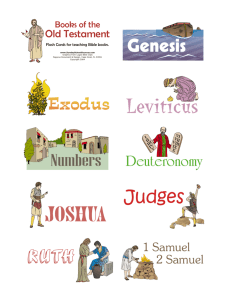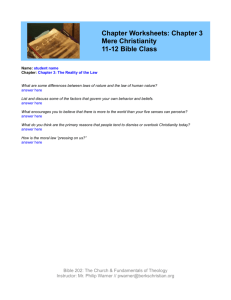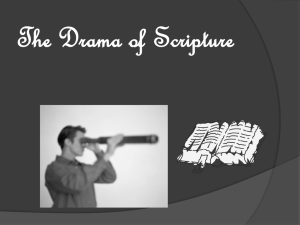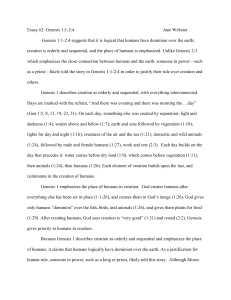01intro
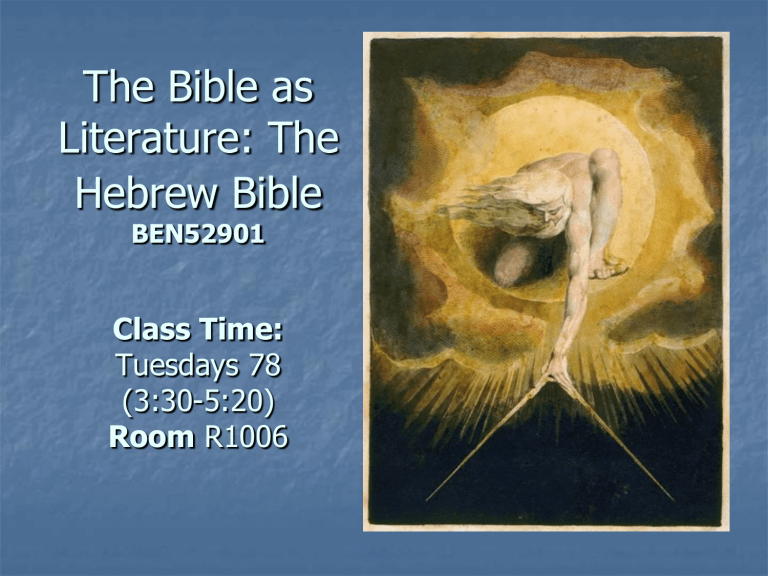
The Bible as
Literature: The
Hebrew Bible
BEN52901
Class Time:
Tuesdays 78
(3:30-5:20)
Room R1006
The Bible as literature
Literature in the Bible: This approach looks for the most beautiful writing. (This is not our approach)
Bible as literature: the Bible considered in terms of its human authors, contemporary subjects and literary forms, original languages and translations, and development through time as an anthology of documents.
When we study the Bible as literature, it is not important to think about whether the events actually happened or not. What is most important to think about is what did the authors think about the events they wrote about and what did they want their readers to think?
A Literature Class
The most important thing for you to do in this class is to read the assigned reading each week. You can use Chinese to help you understand, but Read in English .
Know the Bible language and stories in
English.
The TaNaK
(the 3-part Hebrew Bible )
T
orah
( The Law , Books of Moses, Pentateuch)
Genesis, Exodus, Leviticus, Numbers, Deuteronomy
N
evi’im
( The prophets )
The former prophets: Joshua, Judges, 1&2 Samuel, 1&2 Kings
The latter prophets: Isaiah, Jeremiah, Ezekiel, The scroll of the twelve (Amos, Hosea, Micah, Joel, Obadiah, Jonah, Nahum,
Habakkuk, Zephaniah, Haggai, Zechariah, Malachi)
K
ethuvim
( The Writings ) (written after exile)
Psalms, Job, Proverbs
Ruth, Song of Songs (Song of Solomon), Ecclesiastes, Lamentations,
Esther
Daniel, Ezra-Nehemiah, 1-2 Chronicles
Christian Old Testament
Pentateuch Historical
Books
Genesis
Exodus
Leviticus
Numbers
Deuteronomy
*Yellow text designates books in the Roman Catholic and Greek Orthodox
Old Testament
Joshua
Judges
Ruth
1 Samuel
2 Samuel
1 Kings
2 Kings
1 Chronicles
2 Chronicles
Ezra
Nehemiah
Tobias
Judith
Esther
1 Macabees
2 Macabees
Poetry and
Wisdom
Job
Psalms
Proverbs
Ecclesiastes
Song of Solomon
Wisdom of
Solomon
Sirach
Prophetic
Books
Isaiah
Jeremiah
Lamentations
Baruch
Ezekiel
Daniel (additions)
Hosea
Joel
Amos
Obadiah
Jonah
Micah
Nahum
Habakkuk
Zephaniah
Haggai
Zechariah
Malachi
Documentary hypothesis
The view that the Pentateuch and books immediately following were artfully created by combining a number of older documents into a single, sustained account.
Scholars have come up with 4 discernable sources they have named: P , J , D , and E .
The ancient editors who created finished versions of texts out of earlier materials are called redactors .
P “Priestly” Source
Scholars think this source was the latest written.
Concerned particularly with religious ritual and the regulation of behavior.
Emphasizes genealogies, formal language, legal codes, ritual.
Opens and closes the Pentateuch.
J “Yahwist” source
Scholars think this is the earliest source characterized by an anthropomorphic view of the deity, whom it designates as
"Yahweh," (also “Jehovah”) and by its fine storytelling and its earthiness.
Emphasizes important role of women.
D “Deuteronomic” source
Scholars think this was the third source written.
notable for its declamatory style and its insistence upon the view that faithfulness brings rewards, unfaithfulness brings punishment
Some think this source is almost exclusively found in Deuteronomy.
E “Elohist” source
Scholars think this is the second oldest narrative strand.
characterized by its representing the deity, whom it designates as "Elohim," as appearing to humans in dreams and through angels
“Elohim,” rather than “Yahweh” is the preferred name of God.
Often exists as small fragments combined closely with J’s narrative.
Read Genesis 1 and 2
Note the different versions of the creation story.
Name as many differences as you can.
Especially, note how God is characterized differently.
What are his qualities in each account?
The first chapter of B'reshit, or
Genesis, written on an egg in the
Israel Museum.
Who wrote the first creation account?
Who wrote the second creation account?
Reading for next week
What happens repeatedly in almost each of the
4 primeval narratives?
What does the writer want readers to think about God?
Adam & Eve in the Garden (sin enters world)
Cain & Abel (first murder)
Noah (second chance)
Babel (challenging God)
Also look for two distinct narrative strands in the flood story. Who do you think wrote which?
Creation of Adam (1510)
MICHELANGELO Buonarroti
Ceiling of the Sistene Chapel
painting
